Posts Tagged ‘tenkara net’
Visiting the tamo shops
Early this week I looked at my calendar and Wednesday was a free day – I have been busier on this trip than I had ever imagined. So, I decided to revisit the tamo shops a couple of hours away from here. This was my third visit. I actually had to return before I leave to pick up a couple of pre-ordered mesh bags for my nets. But, mostly I was excited to look at all the nets I could before the end of my trip.
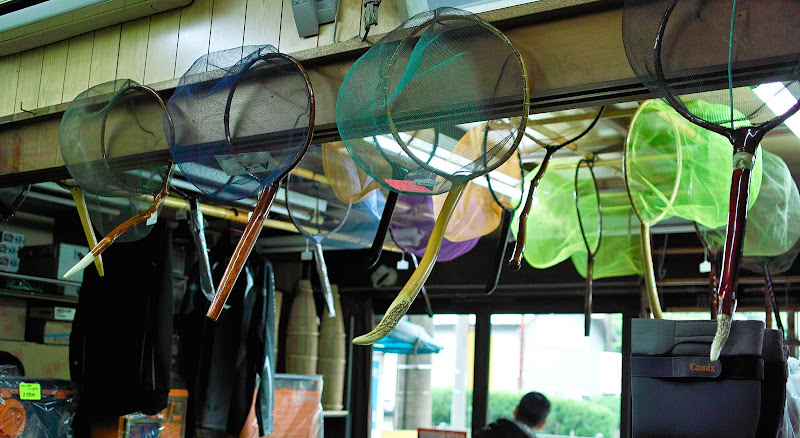
On the drive over, I noticed the same mountains I had seen when driving with Chris a couple of weeks ago. This time I found a better viewing spot and was able to setup my tripod for a more stable shot and some video.
Last year Dr. Ishigaki took me to visit one of the stores, where I fell in love with tenkara nets. Then, a few weeks ago Eiji Yamakawa and his friends came to this area, but as it was raining very heavily on our second day they decided to visit the tackle shops instead of going fishing, I tackled along. This time I wanted to go on my own. I wanted to take my time in observing the style of different net makers and I wanted to talk to the owners of the stores with no rush, no time to go back, and without feeling like I’m taking someone else’s time. Furthermore, this would be excellent Japanese practice.
My Japanese is still very crude, but I’m finding that on the topic of fishing I have been holding decent conversations, being able to ask the questions I want (even if sounding like a Tarzan), and understanding most of the responses. Sometimes I still count on my iPhone, which in Japan has become an expensive dictionary, though I’m relying on that less and less. Also, I do keep a small moleskin notebook and pen with me at all times and take note of new words and refer to ones I learned before. I have had numerous hour+ long conversations here, and those have been some of the most fun (though challenging) experiences in Japan. There is something about living on the country-side, where people seem open to taking their time in conversing with a stranger, arriving at common grounds and sharing common experiences. Whereas most encounters in big cities seem dictated by a one-hour time block, here I have sat for a cup of coffee and talked with people with no pre-allocated amount of time. Sometimes conversations are quick, other times 3 hours long, nonetheless each is a big opportunity to learn about 10,000 new things.
(by the way, though tenkara is mostly for smaller fish, if you still think it is only for the very small fish, take a look at the mounted fish on Shimizu’s wall, fish of that size or larger are a common decoration on walls of businesses in this area)
The first tamo shop I stopped at is owned by Shimizu-san. By far my favorite store and where I got my first net last year. A few weeks ago when we tried to stop by they were closed, so I was happy to find his store opened on this visit. Shimizu-san’s store has been around for about 40 years and was previously owned by his father. At this time of year, ayu fishing season is starting and the river across the street from his store was filled with ayu anglers (more on this later). A couple of times fishermen came in dressed in their neoprene waders to talk to Shimizu, as I admired each of the nets he had on display. This year’s collection of nets from different makers was nothing short of extraordinary. The nets were much more expensive than they had been last year, but each of the nets was of very high quality. Also, his store only stocked kaya-tree nets this year, as opposed to nets made from other trees like the “momi”. He says kaya nets are the best and he’s not carrying nets from other woods this year. He and I had a good conversation. I didn’t meet him last year, but he said his wife had mentioned meeting me last year.
Then, I revisited another store where I had stopped a few weeks earlier. I actually had to return to the area before I left since I had pre-ordered 2 custom mesh bags from the maker. I had asked if they had any mesh bags to sell, but they didn’t, preferring instead to use the bags for their own nets. However, he agreed to prepare a couple for me and have them ready within about 10 days. So, I stopped there and picked them up for my upcoming kaya nets. Here’s a picture of the maker about 30 years ago, this picture hung on the wall:
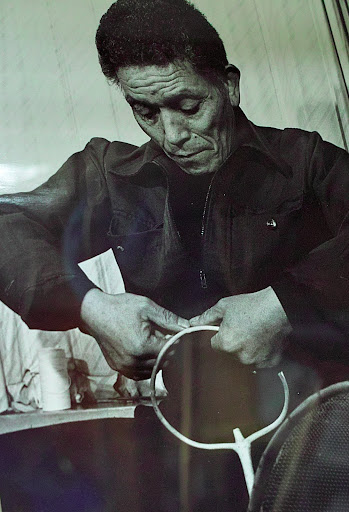
Photo updates from Japan
I know, I know – I promised to write a bunch while on my “sabbatical” in Japan, and I haven’t been delivering. I have been fishing though. I have fished with a bunch of great people and some of the masters of the art of tenkara. I have been enjoying some of the most beautiful streams I have seen and seeking others. I have also found some wood for my new tenkara nets. So much going on, so little time. It’s already been almost 20 days since I arrived in Japan. And, yes, I have been learning more about tenkara. I will share more. Meanwhile, here are some pictures from the last couple of days:
A gorgeous stream, a “shiryu”, or “tributary” of the Mazegawa:
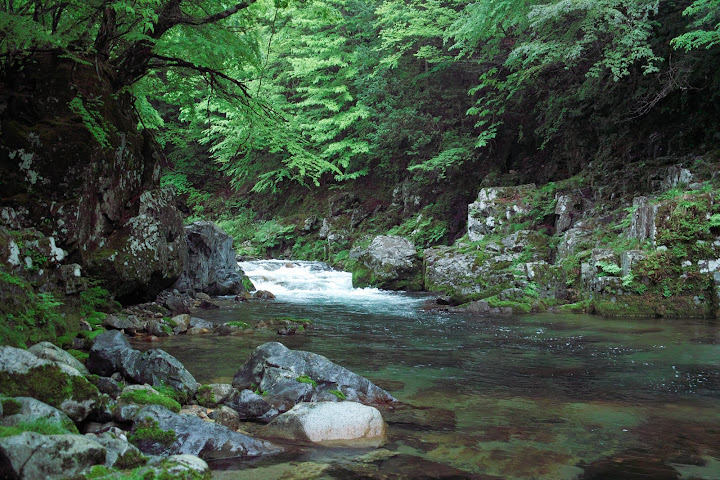
While many people take a lot of fish, I’m happy to know fish can find sanctuaries of gorgeous water, but no fishing allowed, this is what the sign looks like:
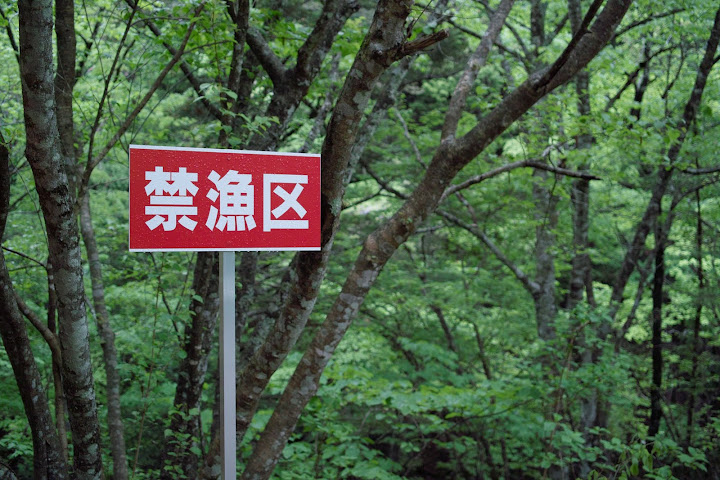
Fishing with Eiji Yamakawa, and two of his friends from their tenkara fishing club, awesome guys:

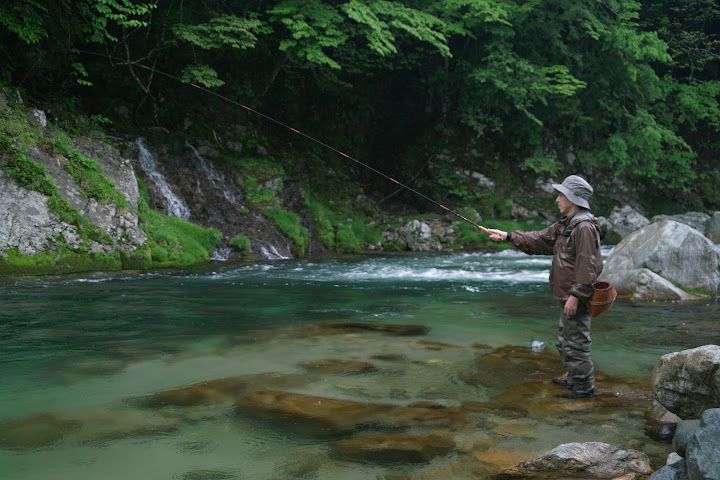
After much looking, finally found the rare “kaya” tree [update: they were not kaya, but rather the more commonly found “momi” trees, I finally found an ancient kaya forest and learned about their differences]. I found the trees 2 days after reading that as much as 45% of the forests of Japan have been replaced with cedar (“sugi”) tree plantations. Indeed, cedar is about all you can find here, but deep in the woods there are other trees. I climbed a kaya momi, and found others where the branches were accessible. What an impressive tree:

Authentic Tenkara Net Auction For Japan Earthquake Relief Efforts
You certainly heard about the tragic earthquake and tsunami that swept through Japan. I’m relieved to report that our tenkara teachers, friends and family are okay, but many others are not.
In an effort to raise funds for the relief efforts that will be taking place in the coming days/weeks/months, I am auctioning off one of my very prized and extremely rare tenkara nets (tamo), made in Gujo by tamo master Ikichi-san. I feel greatly indebted to the people of Japan for teaching me about tenkara, and for always kindly welcoming me. 100% of the proceeds will go to the relief efforts.
I have written extensively about tenkara nets here http://www.tenkarausa.com/blog/?tag=tenkara-net. I thought you, or someone you know may like the opportunity to acquire this one. 100% of the money raised will be sent to the relief efforts, and the bidder earns a one-of-a-kind net that is becoming rarer by the day. Please pass it on to anyone you feel would like a chance to bid.
Good luck with the bidding and than you for helping.
AUCTION (better pictures, and more info here): http://cgi.ebay.com/ws/eBayISAPI.dll?ViewItem&item=320670445593
Tenkara net gallery
It has been a while since I last posted som ething on tenkara nets. So, I thought I’d give you an update on nets that I have recently finished. Also, be on the lookout this year for more on tenkara nets. I plan on talking more about them, and the advantages they present for stream fly-fishing, particularly mountain stream fly fishing.
ething on tenkara nets. So, I thought I’d give you an update on nets that I have recently finished. Also, be on the lookout this year for more on tenkara nets. I plan on talking more about them, and the advantages they present for stream fly-fishing, particularly mountain stream fly fishing.
This first net was made with a Juniper tree branch, collected in Colorado. It is one of my favorite ones so far. As with all nets, this was a whole lot of work, but the beautiful features on the wood made it all worth it. I also incorporated a deer antler, which I thought would really complement it – and protect me in the water as Japanese superstition goes. As I didn’t want to hide the flaws on the branch, I chose to fasten the mesh to it by using eyelet pins on the bottom of the frame – TONS OF WORK, and I don’t plan to do that unless absolutely necessary as I felt it was for this one.
As with all nets I’m making, this one features my name with Japanese kanji characters on the handle. Dr. Ishigaki, my sensei, is also quite a master with words. He was able to find characters that can not only be pronounced “Da ni e ru”, as you’d pronounce my name in Japanese, but also mean “a person who developed his own casting style” or something to those lines.
The one below is made of a Ponderosa pine branch, collected in the Sierras. I made the hoop larger than most other nets so far. It is a little over 27cm (most that I make are 24cm) in diameter.
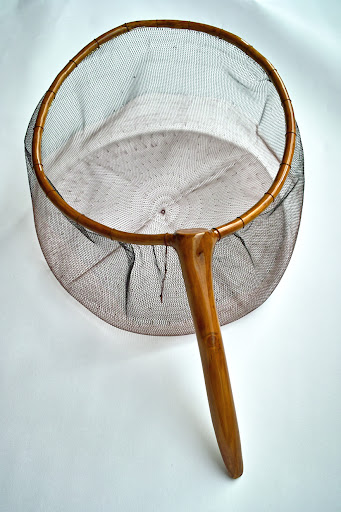
This one is a small net, made with Jeffrey Pine. The diameter of the branches making the hoop are thinner than usual, but it’s very strong nonetheless, and I’d use it with full confidence. The line used to connect the mesh to the frame was twisted polyester line made by my friend and forum user Rick.
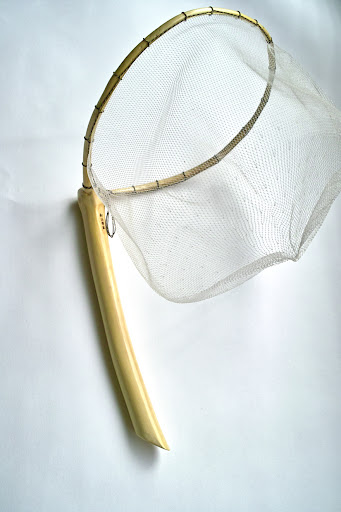
And, below is the “kuroi tamo”, a unique black net. The branch had some parts with interesting lines and features, but was generally boring and not that pretty. Thus, I decided early on to highlight the interesting features by darkening the entire net and having a transparent, and golden tone over on black on those features. They are hard to see in the photographs, but the bottom of the handle and the rounded middle are where you can see it. Unfortunately I think the mesh bag was too small for this one. I was going for a smaller mesh to keep its look more “delicate”, and used a 24cm size. I should have used a 27cm mesh, and will probably change it down the road.

Tenkara nets now available.
I have said it before and will say it again, I have fallen in love with tenkara nets for stream fishing. After a lot of requests for us to offer tenkara nets and a long period spent developing nets that could be made with high quality and consistency, I’m proud to announce that our tenkara nets are finally available.
The best mesh for stream fish.
The super fine mesh of tenkara nets is absolutely ideal for stream fishing. Hand-made with nylon, the mesh has tiny 2mm gaps, which presents several advantages for stream fishing and until now have not been offered to anglers outside of Japan. The very fine mesh gently cradles the fish to minimize damage to its skin. A fish will never get caught in the gaps, as may happen in the wider gaps of some nets where the gills or jaw of fish can sometimes be damaged when they thrash around in other nets. It’s very light weight and retains no water (a quick shake will dry it entirely). And, my favorite, it will not snag your fly.
The best net design
Based on the original “design” of tenkara nets, which are made with one single branch and have a frame positioned at an angle from the handle, one couldn’t come up with a more functional design nowadays. The angle between the frame and handle can serve several purposes.
It allows you to position it on your back, through the wading belt ,while the net stays off your back and allows for free movement. When fishing in shallower water you can press it behind your knees after you net a fish so you can use both hands to manage the fish, or take a picture. If in deeper water, you can also leave the handle through your wading belt on your side as you have both hands free to unhook the fish or take a picture. The round handle also ensures you can position it between your legs, or the positions mentioned above, and it won’t turn. In sum, a very well designed angler’s tool and it has become our favorite picture-taking device.
For more information on why we love tenkara nets so much please see our blog posts on tenkara nets: https://tenkarausa.files.wordpress.com/2010/09/netuse.gif?tag=tenkara-net
We also offer separate mesh for the nets in case you want to venture into making your own tenkara nets.
Manzanita tenkara net
Today I completed my first own tenkara net. It’s made of one manzanita branch, found after much looking and worked on for over a month. The end of the handle features a deer antler tip, which in Japanese superstition is believed to protect anglers in the water.
Raw branch:

MORE PICTURES Read the rest of this entry »
Tenkara tamo, the experiment continued!
I have been having tons of fun searching for the appropriate branches and then embarking on the adventure of making my own tenkara tamo (tenkara nets). As stated, I have fallen in love with tenkara nets!
After spending a few weeks looking for the ideal branches, I was able to find a couple of branches, one from a manzanita bush, the other from the Jeffrey pine. After near a month in the making, I’m getting close to finishing them. The entire process was documented on the forum. Here are the semi-final results.

I loved working on something so simple and aesthetically pleasing. It’s not easy, but doable, and beautiful. The details were difficult, especially joining the two arms of the frame.

Though all nets are unique and one-of-a-kind, the manzanita will be more so because the manzanita does not have the symmetrical branches with the right diameters and angles for a net. The Jeffrey pine, on the other hand, has the ideal shapes and the wood is easier to work with.
I’ll venture to say this is the first manzanita net frame in the world built in this manner, and after studying the manzanita I think it may continue with that title since it was almost impossible to find the right branch for it. It’s my most rewarding project, the wood is absolutely gorgeous, and the outer layer of the stripped bark is red, giving it a beautiful natural color and providing for very interesting patterns on the places I needed to strip and sand. I needed to cut the end of the handle as it was curved in the wrong direction, and I figured I could follow the tenkara tradition of using deer antlers for protecting who uses it in the water. A tenkara enthusiast, who also gave me some great advice, offered to send me some deer antler, and one of them was a great match, having almost the same colors as the wood itself.

Stay tuned for the final pictures in a couple of weeks.
Tenkara nets, an experiment in making one
I told you, I have fallen in love with the simple, organic elegance of tenkara nets. Though I have very little experience with wood work, I have decided to embark on the journey of making one. I have spent weeks looking up at trees trying to find the perfect branches to make a net myself. The branches needed to have just the right angles, the right diameters, be on the right (i.e. healthy) tree, in the right (i.e. legal) location, and be the right wood for this, that I just thought it was going to be impossible to ever make one myself.

Tenkara net, with a manzanita branch
I finally found a couple of branches that just may work, and if nothing else are good places to start the learning process. Through several resources accumulated and the suggestions of people with experience in wood work, I think I may just get to make my own net. I am documenting the experience on our forum, under the newly created category of “tenkara nets”. I was able to find 2 branches of a Jeffrey Pine (this yielded 4 possible nets) and one branch of a manzanita (above). So far I started drying the nets while forming them into shape with strings, removed the bark and did some initial carving on the knots and ends. Now I must let them dry for a while before resuming the work.

The raw net frame assembly.
This is going to be a real fun project.
Tenkara nets
I have absolutely fallen in love with tenkara nets (tenkara tamo in Japanese). As I got to see many examples up close, and learn about how they are made, and about their design, I realized tenkara nets are just masterpieces of simple organic, yet functional design. Each net is a work of art and I’m surprised I haven’t run across one at a museum somewhere. True, I haven’t been this excited about something since I discovered tenkara rods.
One of the main reasons for their appeal is the fact that tenkara nets are made out of a single branch of a tree. How much simpler can it get? No carving, no manufacturing, a simple, organic, tree branch selected and used to make a strong, and functional net frame. Of course, simplicity doesn’t always mean easy, and in this case it definitely does not. A good tenkara net is very hard to make, and it takes a long time to finish.
The process of making a real tenkara net starts with the selection of the wood; this is the most important step, and the defining one in the process. A tenkara net craftsman will spend days walking in the woods in search of the branches that will work well for making a net. He’ll look for just the right branch with the right angles and diameters. After I learned how these nets are made, I have spent a lot of time looking up to trees, trying to identify those branches that may offer the right angles for a net, and they are really not easy to come by, at least not to the untrained eye. As a result, every single net will be a completely unique piece, with lots of effort put into each one.
Traditionally tenkara nets are made with branches from the kaya tree (Torreya nucifera), a relatively rare type of conifer tree found in southern Japan and an island in South Korea. The trees are a protected species; they are slow growing trees, confined to a small area; thus, any branches that are found are even more highly prized. While I believe many other trees may work, the kaya seems to be ideal for these nets, it’s durable and hard yet lightweight, the wood has interesting patterns and a uniform grain. One of the nets I purchased, a slightly “large” one with a longer handle weighs a mere 3.5 oz. Occasionally bamboo is also used, though bamboo is not as durable for this application, and more difficult to work with, so makers tend to prefer wood branches.
In Gujo, Gifu prefecture, we visited a shop that specializes in tenkara nets. The store is run by the artisan and his wife and almost all nets are made by him. It is one of the few places in all of Japan that makes and carries thems. It’s a wonderful display of unique and authentic tenkara nets, some simple and functional, some with unique wood features, and some featuring ornamental deer antlers, which are said to protect anglers in the water. Yes, I did feel like a “kid in a candy store”.
The design and features of a tenkara net
Tenkara nets are just perfectly designed, even though no one ever really designed one, and even though I’ll suspect no tenkara net is never really “perfect”. As a matter of fact, imperfections are more than welcome on the nets, there is no need for the frame to be perfectly leveled or for the wood to be free of “flaws”. This may actually be their allure. The natural aspect of each branch is fully embraced by the maker, and by the angler. I think the concept of wabi-sabi applies well here. I have always been a big fan of Japanese design, and with so much inspiration from all aspects of life, even fishing, it’s no wonder Japanese design tends to be so clean, and functional.
The round shape of the net comes from the way the nets are made. Essentially one gets a branch that is Y-shaped (normally a trident shape, where the middle branch is cut off), and through a process of drying and steaming the wood, as well as forcing it into shape, bends the net frame into a circle. The reason for a circle shape is simple, a circle is the strongest shape that can be made to receive pressure or hold weight. Thus, a good circle is also a good indicator of the quality of the net. The circular frame is the best shape to uniformly distribute the pressure a fish puts on the frame, as well as on the net mesh.
The angle between the net frame, and the handle, is also an important functional attribute. As I experienced, this angle is supposed to help in a few ways. When wearing a wading belt (or a regular belt for that matter) the angle keeps the mesh and frame off one’s back, thus allowing the angler to move freely as he walks or climbs over a rock.
Further, the longer handle usually found on a tenkara net along with that angle allows for the handle to be held behind the knee as one is kneeling on the water, while having the net and fish facing slightly forward. This allows for the tenkara angler to have both hands free as manages the fish, removes the fly, and yes, takes a picture. If one is wading a bit deeper, the same may be done by having the net held by the wading belt, or even under the arm pit as he manages the fish at a comfortable angle and with both hands. Yes, ingenious design!

Click below for some very instructive web pages (in Japanese) on making the nets.


